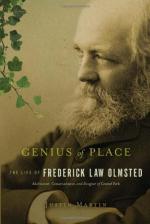|
This section contains 373 words (approx. 2 pages at 300 words per page) |
Encyclopedia of World Biography on Frederick Law Olmsted
Frederick Law Olmsted (1822-1903), American landscape architect, was prominent in promoting and planning recreational parks across the country.
Frederick Law Olmsted was born at Hartford, Conn., on April 26, 1822. He did not matriculate at college because of weak eyes, but he attended lectures at Yale University intermittently and became an honorary member of the class of 1847. He also studied engineering. In 1844 Olmsted decided to become a farmer and, after getting practical experience, settled on Staten Island, where he operated a farm until 1854. In 1859 he married Mary Cleveland Perkins Olmsted, the widow of his brother; the couple had two children.
In 1851 Olmsted visited Andrew Jackson Downing, who with others had conceived the idea of creating a vast park in New York City. Before realizing his dream, Downing died. Olmsted kept the idea alive and in 1857 was appointed superintendent of what became Central Park. He and Calvert Vaux then won the design competition for the park, and in 1858 Olmsted was advanced to chief architect of Central Park. During the Civil War he resigned his appointment over political differences and in 1863 accepted the superintendency of the Frémont Mariposa mining estates in California.
When Olmsted returned to New York in 1865, he and Vaux were reappointed landscape architects for Central Park. The Olmsted firm became the foremost landscape architects in America. Their projects included Prospect Park, Brooklyn (1865); the village of Riverside near Chicago (1868); Mount Royal Park, Montreal (1873-1881); the grounds of the Capitol, Washington, D.C. (1874-1885); the Boston park system (1875-1895); Stanford University, Palo Alto, Calif. (1886-1889); and Jackson Park, Chicago (1895). Olmsted's most important late work was the design for the World's Columbian Exposition, Chicago (1890-1893).
Restless by nature, Olmsted traveled frequently and often published his diaries and talks. He wrote Walks and Talks of an American Farmer in England (1852), A Journey in the Seaboard Slave States (1856), A Journey through Texas (1857), and A Journey in the Back Country (1860).
Always interested in publishing, he and C. S. Sargent founded the journal Garden and Forest. Olmsted further encouraged park planning by publishing Public Parks and the Enlargement of Towns (1871) and A Consideration of the Justifying Value of a Public Park (1881). He died on Aug. 28, 1903, having witnessed the enthusiastic development in American cities of public park systems.
|
This section contains 373 words (approx. 2 pages at 300 words per page) |


